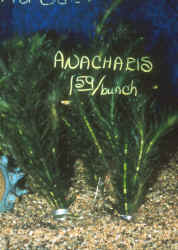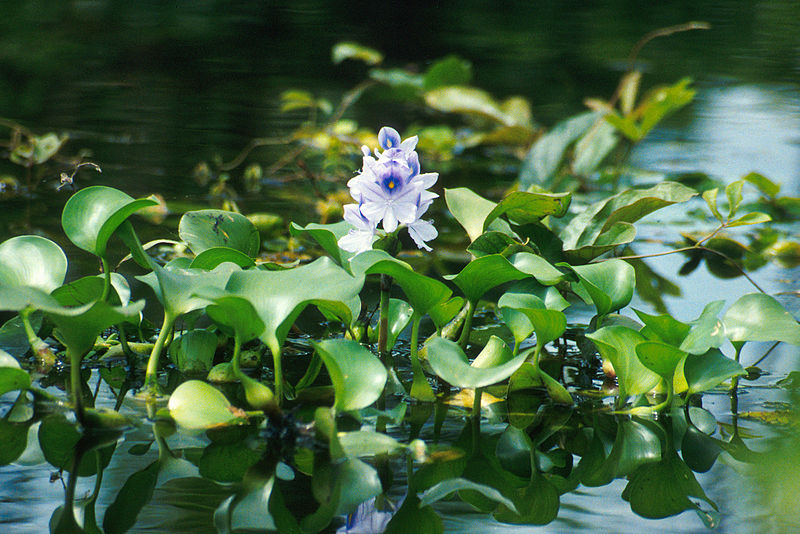Azolla (Azolla Caroliniana) .

Azzola Caroliniana, this tiny floating plant is considered the smallest of the fern family. It is sometimes confused with Duckweed but actually looks very different. Duckweed has smooth bright green leaves and Azolla has crinkly rough textured leaves that are a darker sage-green in color and that develops a reddish tinge in bright sun. The two lobed leaves overlap in rows like fish scales. Threadlike roots hang down from the undersides of the leaves.
Azolla likes sun but will tolerate some shade. It likes moist, warm air and does not do well in an aquarium. It usually will not survive the winter if temperatures fall below 50 F. It grows very fast and can become a problem in a big pond unless you can net it out regularly. If you want to cover the surface of a smaller pond fast, it is a good choice. This will give protection for small fish from birds. Azolla is used in Panama and elsewhere to carpet water surfaces to prevent mosquitoes from laying eggs. Fish like to eat Azolla when the diet is not balanced.
Common Duckweed (Lemna Minor)

This floating perennial is commonly mistaken for pond scum in natural ponds. If you look closely, you will see a thick carpet of tiny, individual bright green plants which are actually very attractive. Each small leaf (about 1/8" long) is a complete rooted plant which reproduces by budding, resulting in a chain of little, massed plants. It reproduces very rapidly but will be forced out by Azolla if grown together in a small container. It is an excellent food source for Koi and they do not get tired of feeding on Duckweed. To grow Duckweed in an aquarium, you need first to keep a sufficient amount out of the reach of your fish so it can reproduce. It prefers still or very slow moving regular aquarium water, florescent grow lights, and, if possible, a sealed environment to trap humid air. It will grow year around in this environment and you will be able to take out big clumps to feed your fish. Outside it will bleach out in full, direct sun so partial shade is ideal.
Anacharis (Elodea) is the most common and easily recognized submerged aquarium plant. It is a vigorous grower in the aquarium or pond and is an excellent oxygenator. It forms dense masses of foliage which can provide hiding places for fry Anacharis has short, dark-green lance-like leaflets whirled along the entire length of the brittle, branching stem. It spreads by runners and as the plant extends itself, the growth at the older end becomes yellow and loses leaves. This old growth can be pinched off leaving the healthy new growth Anacharis may flower for you.

These will be charming 1/4" white floating flowers on threadlike stems. Anacharis is very easy to grow and does not seem to have any special requirements except sufficient light. It grows better in potted soil or just left floating to form long roots that trail down in search of soil to anchor the plant. It needs to be brought inside from a pond at the end of the summer. The temperature should be no lower than 5 celcius to live through the winter.
Water llyacinth (Eichhomia Crassipes) is a tropical floating plant with long, hanging roots which are the instinctively favorite spawning material of Koi and goldfish. Fortunately it is also a beautiful plant.
The shiny green leaves are on air-filled bulbous stems which are also filled with a spongy material that keeps the plants afloat. These leaves and stems spray outward from the center of the plant in a rosette shape. The Water Hyacinths flowers are similar to the Land Hyacinth. They look like a little purple orchid on a long stem coming from the center of the plant. The plants will flower more frequently if the roots touch bottom sediments.
Water Hyacinths need full sun. Each plant is l0"-12" tall. They are perennials. They can be wintered over indoors but they are fussy. They need lots of light, and moist air. Propagation is by runners at the water surface and is rapid. These are among the fastest growing plants in the world. In tropical areas they have cloggedwaterways and stopped navigation on rivers . Luckily, this should not be a problem in your pond unless you have a very large or natural pond.
Water Hyacinths pull nutrients out of the water at such a rate that they have been introduced in many areas to clean up foul, stagnant water. Water reclamation plants are experimenting with ammonia directly
Water Cress (Nasturtium Officinale) is a hardy annual that grows naturally in the soil on the banks of cool to cold streams and spring-fed ponds. It can be found all winter long in unfrozen, sheltered areas. This is the same Water Cress that is sold in grocery stores and used in restaurants. You can eat the leaves and stems that you grow. They have a very peppery taste. Waterfowl eat it and fish like it also. The small floating leaves are rounded, dark green and waxy. The branching stems can spread out for 2'-3' over the surface. Slender roots hang down from the nodes of the stems. It is a very good oxygenator.
It develops many small white flowers over the growing season. Plant in garden soil and put the pot by the edge of your pond with a couple of inches of water over the pot. It will do fine in an area of moving water. Water Cress will quickly form a mass of foliage and can outgrow a small pot within two months. You may see the root mass growing over the surface of the soil them as they take in growth of the plant may slow and become scraggly. Either re-pot the plant in a larger pot or chop out a big chunk of the plant and the root mass then fill the hole in with soil. Water Cress tolerates sun, shade or partial shade equally well.
It is easily grown frorn the tiny seeds found at any gardening center that has a decent seed selection. It is also a prolific re-seeder and will re-sow itself yearly. You can also start it from a freshly purchased bunch at the produce section of the grocery store. Make sure you can see the fine white roots on some of the stalks... Push these into wet soil and soon you will have enough Water Cress for all of the salads and sandwiches you could possibly want.
Source :
1. http://akca.org/library/wtrplant.htm
2. Pic From Wikipedia